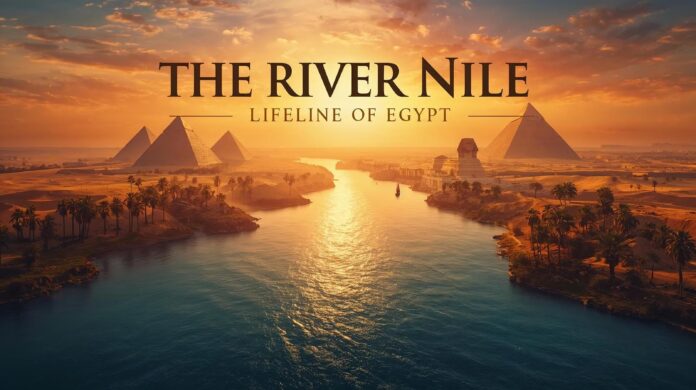The Nile is an important river of Africa that falls into the Mediterranean Sea. Its length is 6650 kms. It flows through eleven countries – DR Congo, Tanzania, Burundi, Rwanda, Uganda, Kenya, Ethiopia, Eritrea, South Sudan, Sudan and Egypt.
The Nile has two major tributaries – White Nile and Blue Nile. After Khartoum, the Nile flows northwards through the Nubian Desert and Cairo. At Alexandria, it joins the sea. Since ancient times, Egypt and Sudan have depended on the Nile and tolerated its flooding also. Almost every year, the Nile is on spate. A dam is built on the Nile. It is called the Aswan Dam. All the cultural and historical sites of Egypt are found along the Nile bank.
The Nile is the lifeline of the civilization of Egypt since the Stone Age. The Greek historian Herodotus said – Egypt was the gift of the Nile. The Nile has an unending source of sustenance. The annual flood of the Nile is a blessing in disguise. Every year the Nile deposits new layers of silt, making the land fertile. The Ancient Egyptians cultivated and traded wheat, flax, papyrus, and other crops around the Nile. Wheat was a major crop in the Middle East, as famine frequently came. The Egyptians have an emotional relation with the Nile. A tune Hymn to the Nile was created and sung by Ancient Egyptians at the time of the annual flood.
Two things are important to the inhabitants of Egypt (ancient name Misser) – one is the Sun God and another is the River Nile. The Egyptians considered themselves as the progeny of the Sun. They are children of the Sun God, and the River Nile is their lifeline. In spiritual life also, the Nile comes to them. The Nile is thought to be the causeway from life to death and afterlife. For them, the east is the place of birth and growth, and the west is the place of death. The Sun, moving from east to west, undergoes birth, death, and resurrection each day. The Ancient Calendar of Egypt was based on three cycles of the Nile: (1) Akhet – means inundation, (2) Peret – growing season, (3) Shemu – harvest season. The Nile is integral to Egyptian life.
Europeans did much research to find the source of the Nile. John Hanning Speke was the Victorian explorer who first reached Lake Victoria and established it as the source of the Nile. There was great debate about Speke’s discovery, but H.M. Stanley, the Welsh American explorer, confirmed Speke’s discovery by circumnavigating Lake Victoria. Speke named the Lake after Queen Victoria.
The Nile has been a good transporter of goods. Winter wind blows south, up river, so ships could sail up river and down the river along with the flow. Most Egyptians live in the Nile valley. After the completion of the Aswan Dam in 1970, the summer floods came to an end. The Nile’s flow is disturbed at several points by cut reeds of the Nile, which form an obstacle to navigation by boats.
All told, the Nile plays a pivotal role in Egypt. Without the Nile, life is impossible in Egypt. Egypt is the gift of the Nile, and the Nile is the gift of God. It is no exaggeration. Historians and anthropologists have much interest in Egypt and the Nile.
(The views expressed are the writer’s own.)

Radhakanta Seth is a Former Income tax officer in Sambalpur. He is a Freelance writer and his articles have been published in some Oriya dailies like Sambad, Samaj, Dharitri and English dailies like The Telegraph and in a sociological journal ‘Folklore’ published from Kolkata.
(Photo has collected from net )

